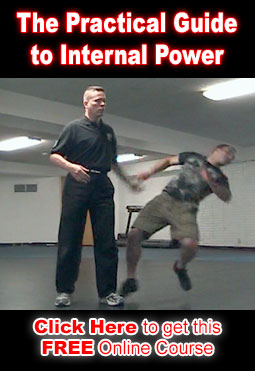Why slower?
So, first the training benefits of slower. (we’ll get the martial application in a minute.)
Start slow to learn then speed it up.
Obviously you need to train at medium and fast speeds on a regular basis.
The thing with the Internal Martial Arts is that we’re always adding layers of depth and refining to a higher level.
So, for example, in the Tai Chi section of the Internal Combat Arts course…
www.clearsilat.com/internal-combat-arts
…you learn how to dissipate a punch using movement & softness.
You start slow. That way you learn the skill and no one gets hurt.
Then you have 2 options.
1) Slowly increase the speed until you can do this against a full speed attacker.
OR
2) Refine the skill.
Stay slow or go even slower. Use less movement. Use more softness. While getting even better dissipation of the incoming force.
Of course you should do both.
You also learn a bunch of different ways to generate power in the Internal Combat Arts course. (Around 6 – 8 different methods. I’ll count up exactly how many soon.)
So you learn several of them. Then you have the same two options with each of them.
You use option 2 to continually refine them and increase the amount of power they generate.
Then there’s a third option.
3) Combine.
You take the power methods and the dissipation skill and you start combining them. So they all happen at once. Correctly.
Then we’re back to the first two options… …and of course we do both.
It’s a never ending cycle of refining skills and combining skills.
…and so the ‘start slow to learn’ part of that first statement never ends.
Now the martial benefit of slowness.
We have to assume the attackers are faster than us.
If you don’t make this assumption you are in for a very unpleasant surprise,
…if you ever have to use your art for survival.
So, we must train to use Position, Timing to overcome faster opponents.
(Of course we build speed too.)
The good news is that not only will Position and Timing beat speed.
Position and Timing will continually improve as long as you work on them.
…at some point your speed will decline no matter what you do.
So, if you move faster than your partner you are making a dangerous assumption and building bad habits.
(Moving sooner than your partner is ok. Faster is not.)
Moving at the same speed as your partner(s) is ok.
Moving slower than your partner(s) (and learning to still completely dominate the situation) is better.
The way we often determine speed on slow drills & sparring is:
Go as fast as you can while still being able to see EVERYTHING you and your partner are doing from head to toe. Training this way will rapidly increase the speed at which you perceive everything that is happening around you.
When you start to get good at moving slowly your partners will begin to walk right into things because your position is smarter and they are moving faster than what they can effectively perceive.
So, take all the different push hands games and drills in the Internal Combat Arts Course and spend time training them at an excruciatingly slow speed.
If you put in the time to do that, you’ll find your skill actually increases faster.
One last thing, instead of starting slow and speeding up. Try starting slow and slowing down. This will magnify the benefits discussed above and you’ll get other things out of it as well.
